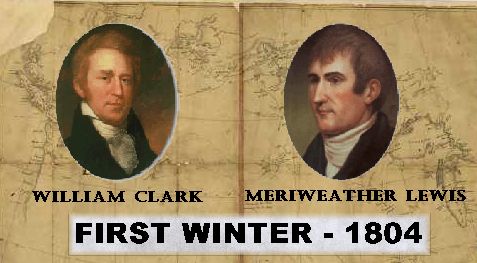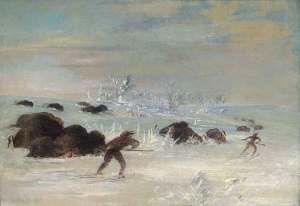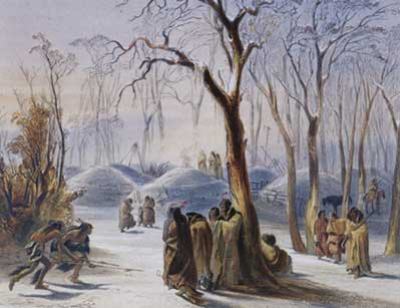 |
 |
| Home | Welcome | What's New | Site Map | Glossary | Weather Doctor Amazon Store | Book Store | Accolades | Email Us |
 | |||||||||
Lewis and Clark's First Winter Two centuries ago, President Thomas Jefferson authorized the Corps of Discovery led by Meriwether Lewis and William Clark to explore the virtually unknown lands of the Louisiana Territory. Within the mandate given them by President, and weather buff, Jefferson was the keeping of detailed weather diaries, the first collection of weather data from west of the Mississippi River. On 14 May 1804, the Corps expedition of 29 men left St. Louis on a keelboat and two pirogue boats.
On 6 November, the party witnessed a strong display of the Northern Lights. Lewis described the event as a pale but brilliant white colored light with shapes various and fantastic — streaks rising perpendicularly from the horizon. Lewis wrote [note all spelling and grammar are as found in the journals]: " last night late we were awoke by the Sergeant of the Guard to See a Northern light, which was light (but) not red, and appeared to Darken and Some times nearly obscured, and open (divided about 20 degrees above horizon – various shapes– considerable space) many times appeared in light streeks, and at other times a great Space light & containing floating collomns which appeared to approach each other & retreat leaveing the lighter space at no time of the Same appeareance." By 13 November, the depth of the snow in the woods measured over a foot. Though the snow accumulated all winter, the Corps appears to have been spared the severe blizzard conditions so famous in the Dakotas. The morning of 16 November, the Corps awoke to a very thick frost that greatly impressed Corpsman John Ordway. His journal described the event thus: "a cold frosty night. the Trees were covered with frost which was verry course white & thick even on the Bows of the trees all this day. Such a frost I never Saw in the States. the air verry thick with fogg from the R[iver]." 29 November 1804: Clark observed: "A very cold windy day. Wind from the N.W. by W. Some snow last night. The depth of the snow is various in the woods, about 13 inches." On Saturday, 8 December 1804, Clark wrote in his journal: "a verry Cold morning. The Thermometer Stood at 12d below 0 which is 42d below the freesing point, wind from the NW....I felt fatigued haveing run after the Buffalow all day in Snow many Places 18 inches Deep, generally 6 or 8, two men hurt their hips verry much in Slipping down." A few days later, 11 December, Clark noted the appearance of sun dogs: ."..a verry Cold morning Wind from the north The Thermometer at 4 oClock A M. at 21o below 0 which is 53o below the freezing point and getting colder, the Sun Shows and reflects two imigies, the ice floating in atmospear being So thick that the appearance is like a fog Despurceing."  "Buffalo Hunt on Snowshoes" by George Catlin (1844/45).Lewis reported that the temperature the morning of 12 December was 38 below zero. He added: "Great numbers of those animals [buffalo] are near our fort but the weather is So Cold that we do not think it prudent to turn out to hunt in Such Cold weather, or at least untill our Consts. are prepared to under go this Climate." The temperature moderated some prior to Christmas. Clark noted on 20 December: "The wind from the NW a moderate day, the Thermometer 37o above 0..." Christmas Eve had some snow in the morning. On 28 December, the wind blew and drifted the new snow. Clark wrote:"Blew verry hard last night, the frost fell like a Shower of Snow, nothing remakable to day, the Snow Drifting from one bottom to another and from the leavel plains into the hollows &c." In general, the frigid cold they experienced that winter was unlike any they had known in the southeastern United States. Corpsman John Ordway wrote: "the weather gits colder very fast." The snow and the cold persisted through January and February, made worse by the cold prairie winds. The mean temperature recorded that winter was 4oF with the coldest temperature dipping to 45 degrees below zero, according to Clark, on 17 December. (Climate records from east of the Mississippi indicate a very cold winter for 1804-05.)  "Winter Village of the Minatarres" by Karl Bodmer, (1833).On 10 February 1805, Lewis wrote " This Morning was Cloudy after a slight Snow which fell in the course of the night the wind blue very hard from N.W. altho' the thermometer stood at 18o. above naught the violence of the wind caused a degree of could that was much more unpleasent than that of yesterday when thermometer stood at 10o. only above the same point. " The tide of coldest winter began to turn. Clark's journal entry for 22 February 1805 reported: "a Cloudy morning, about 12 oClock it began to rain, and Continud for a fiew minite, and turned to Snow, and Continud Snowing for about one hour, and Cleared away fair. " The following week, the Corps was able to disengage their boats from the river ice. March brought an early spring thaw and typical windy North Dakota spring weather. On 25 March, the river ice began to break up. Two days later Clark reported the wind was still strong from the SW, the ice occasionally stopping for a few hours. Signs of spring arrived and on 1 April, a thunderstorm hit the fort. Lewis wrote: " The fore part of to day haile rain with Thunder & lightning, the rain continued by intimitions all day, it is worthey of remark that this is the 1st. rain which has fallen Sence we have been here or Sence the 15 of October last, except a fiew drops at two or three defferent times." On the afternoon of 7 April 1805, the Corps headed westward toward their goal, the Pacific Coast. Learn More From These Relevant Books
|
|||||||||
 |
To Purchase Notecard, |
Now Available! Order Today! | |
 |
 |
NEW! Now |
The BC Weather Book: |


